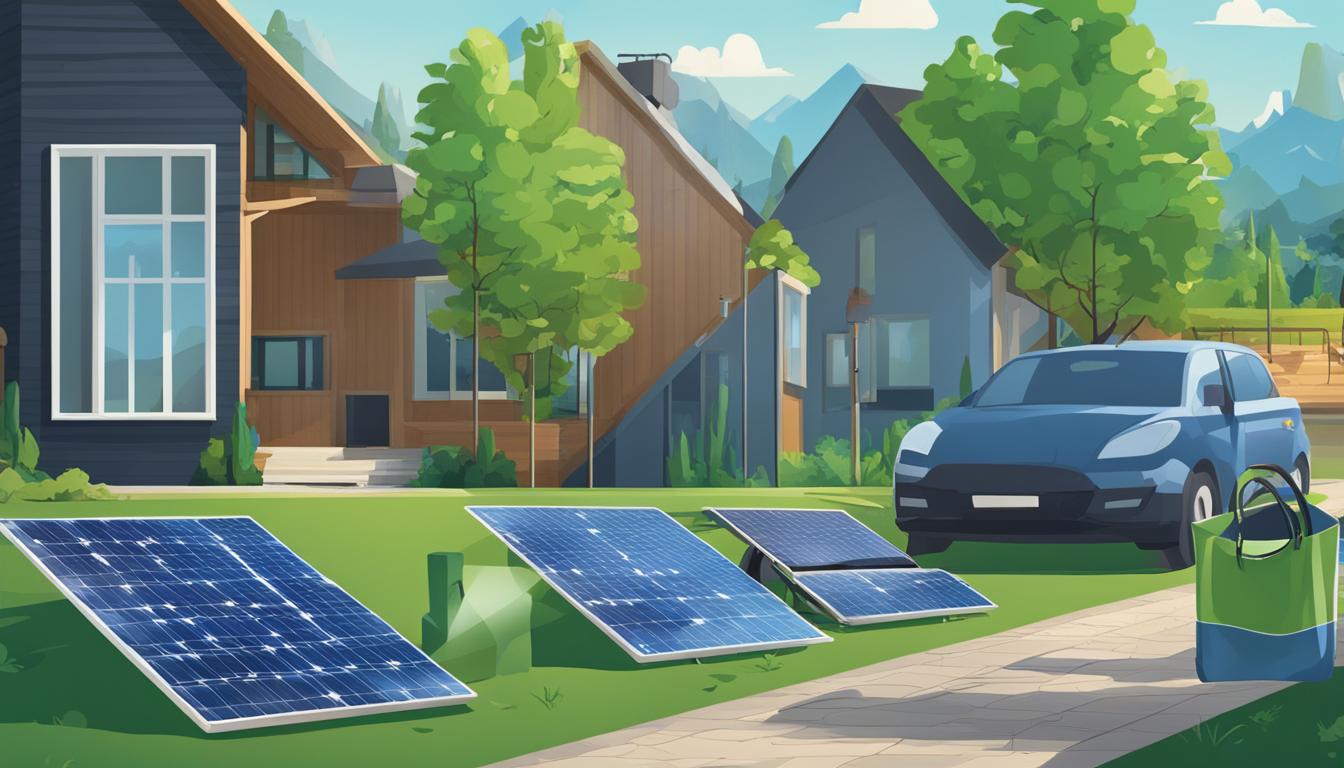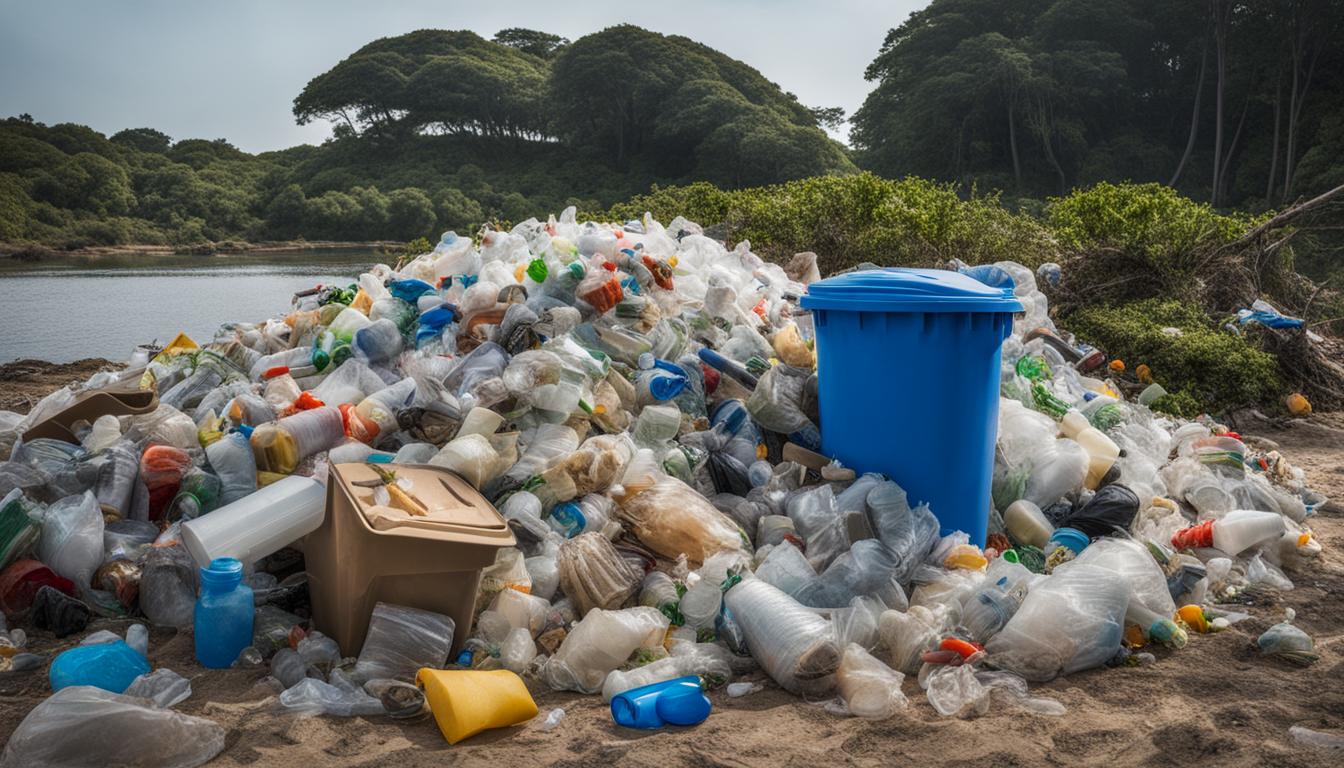Adopting an eco-friendly lifestyle is crucial for reducing our carbon footprint and making a positive impact on the environment. By implementing simple, practical steps in our daily lives, we can minimize our carbon emissions and embrace a sustainable lifestyle.
Key Takeaways:
- Embrace plant-based eating to reduce your carbon footprint.
- Practice the three Rs – reduce, reuse, and recycle – to minimize waste.
- Conserve energy at home by adopting energy-saving habits.
- Opt for renewable energy sources like solar power.
- Choose sustainable transportation options such as public transit or electric vehicles.
Embrace Plant-Based Eating
Eating a plant-based diet is not only beneficial for your health but also plays a crucial role in reducing your carbon footprint. By opting for eco-friendly food choices, such as fruits, vegetables, grains, and legumes, you can make a positive impact on the environment.
Animal agriculture is a significant contributor to greenhouse gas emissions, deforestation, and water pollution. By reducing your consumption of animal products and embracing plant-based alternatives, you can minimize the environmental impact associated with livestock production.
Choosing plant-based options allows you to enjoy a diverse and nutritious diet while simultaneously supporting sustainability. Additionally, plant-based eating can help conserve valuable resources like water and land, making it a win-win for your health and the planet.
Why Plant-Based?
“Eating plant-based foods is not only good for the environment but also promotes a healthier lifestyle. By reducing our reliance on animal products, we can decrease our carbon footprint and contribute to the preservation of natural resources.”
- Plant-based foods require fewer resources to produce compared to animal products
- Plant-based diets can help reduce deforestation and protect biodiversity
- Choosing plant-based options supports ethical treatment of animals
- Plant-based eating can lower the risk of chronic diseases and promote overall well-being
Incorporating more plant-based meals into your diet doesn’t mean giving up taste or variety. There are countless delicious plant-based recipes available that can satisfy your cravings while benefiting the environment.
By making conscious choices in our daily meals, we can all make a significant impact in reducing our carbon footprint and creating a more sustainable future.
Reduce, Reuse, and Recycle
Reducing waste and conserving resources are essential steps in minimizing our carbon footprint and embracing a more sustainable lifestyle. By following the three Rs—reduce, reuse, and recycle—we can make a significant impact in reducing our environmental impact and promoting a greener future.
Reduce: One of the most effective ways to minimize waste is by being mindful of our consumption. This means purchasing only what we need and avoiding excessive packaging. By making conscious choices and opting for products with minimal packaging, we can significantly reduce the amount of waste ending up in landfills.
Reuse: Another important aspect of waste reduction is reusing items whenever possible. Instead of buying single-use products, consider investing in reusable alternatives. For example, using a refillable water bottle instead of buying disposable bottles can help cut down on plastic waste. Additionally, donating or repurposing items we no longer need can extend their lifespan and prevent them from becoming waste.
“Every time you reduce or reuse an item, you are actively contributing to waste reduction and conservation of resources.”
Recycle: Recycling plays a crucial role in diverting materials from landfills and reducing the need for new resources. It is important to familiarize ourselves with local recycling guidelines and ensure that we are properly sorting and disposing of recyclable materials such as paper, plastic, and glass. By recycling, we can conserve energy, reduce pollution, and promote a circular economy.
Create a waste reduction plan:
- Use a compost bin to reduce food waste and create nutrient-rich soil.
- Avoid single-use plastics by opting for reusable alternatives like shopping bags and coffee cups.
- Repair or mend items instead of immediately replacing them.
- Donate unwanted items to local charities or organizations.
- Participate in community recycling programs and initiatives.
- Encourage others to adopt waste reduction practices.
Conserve Energy at Home
Conserving energy in our homes is essential for reducing our carbon footprint and promoting a more sustainable future. By implementing simple practices and adopting sustainable home practices, we can make a significant impact on the environment.
One of the easiest ways to conserve energy is by turning off lights and appliances when they are not in use. This simple habit can save a substantial amount of electricity and reduce unnecessary energy consumption. Additionally, using energy-efficient light bulbs, such as LED or CFL bulbs, can significantly reduce the amount of energy used for lighting without compromising on brightness or quality.
Another effective way to conserve energy at home is by adjusting your thermostat settings. During the winter, lower your thermostat by a few degrees, and in the summer, raise it slightly. This small change can result in significant energy savings while still maintaining a comfortable indoor temperature.

Opt for Renewable Energy Sources
One of the most impactful ways to reduce our carbon footprint is by opting for renewable energy sources. Renewable energy is derived from naturally replenishing resources such as sunlight, wind, and water. By generating our electricity from clean and sustainable sources, we can significantly decrease our reliance on fossil fuels, which are a major contributor to greenhouse gas emissions.

“Renewable energy is not only beneficial for the environment, but it also offers long-term economic benefits,” explains Dr. Sarah Green, an environmental scientist.
“Investing in solar power, for example, not only reduces carbon emissions but also saves homeowners money on their energy bills over time. With advancements in technology and increasing accessibility, renewable energy is becoming a viable and cost-effective option for households and businesses alike.”
Benefits of Renewable Energy:
- Reduced carbon emissions and air pollution
- Less reliance on finite fossil fuel resources
- Lower energy costs in the long run
- Increased energy independence and security
Switching to renewable energy sources like solar power or wind energy not only helps the environment but also promotes sustainable development. Governments and organizations around the world are increasingly investing in renewable energy infrastructure and incentivizing individuals to make the switch. By embracing green electricity options, we can all play a part in creating a cleaner and more sustainable future.
Choose Sustainable Transportation
Transportation is a major contributor to carbon emissions, making it an important area where we can make a difference in reducing our carbon footprint. By opting for sustainable transportation options, we can minimize our impact on the environment and promote a greener lifestyle.
One of the simplest ways to embrace sustainable transportation is by utilizing public transit. Taking buses, trains, or trams not only helps to reduce traffic congestion but also significantly decreases carbon emissions. Public transit systems are designed to transport large numbers of people efficiently, making it a more eco-friendly choice compared to driving individual cars.
Another sustainable transportation option to consider is biking or walking. These activities not only provide a great form of exercise but also have zero carbon emissions. By choosing to bike or walk for shorter distances, we can reduce our reliance on cars and contribute to a cleaner environment.
Electric Vehicles: A Sustainable Choice
Another exciting advancement in sustainable transportation is the adoption of electric vehicles (EVs). These vehicles run on electricity instead of fossil fuels, significantly reducing greenhouse gas emissions. With advancements in technology, EVs now offer longer driving ranges and faster charging times, making them a viable option for many individuals.
In addition to being environmentally friendly, EVs also offer potential cost savings, as they require less maintenance and have lower fuel costs. Many governments and organizations also provide incentives for purchasing EVs, further incentivizing the transition to sustainable transportation.
By choosing sustainable transportation options like public transit, biking, walking, or electric vehicles, we can actively contribute to reducing our carbon footprint and creating a more sustainable future. Let’s embrace these choices and inspire others to join us on this journey towards a greener world.

Practice Water Conservation
Water conservation is a crucial aspect of our efforts to reduce our carbon footprint and protect our planet. By adopting simple habits and making conscious choices, we can make a significant impact in reducing water waste. Here are some practical tips to help you practice water conservation in your everyday life:
- Fix leaks: Even a small leak can waste a significant amount of water over time. Regularly check for leaks in faucets, pipes, and toilets, and promptly fix them to prevent water wastage.
- Install water-saving fixtures: Replace old and inefficient faucets, showerheads, and toilets with water-saving alternatives. These fixtures are designed to reduce water flow without compromising performance, helping you conserve water without sacrificing convenience.
- Be mindful of your water usage: Small changes in our daily habits can make a big difference. Turn off the faucet while brushing your teeth or soaping dishes, take shorter showers, and only run the dishwasher and washing machine with full loads.
- Collect rainwater: Utilize rain barrels or collect rainwater in buckets to water your plants or garden. This helps reduce the need for additional water sources and minimizes wastage.
“Saving water is not only an essential part of environmental conservation, but it also helps us cut down on utility costs and ensures a sustainable future for generations to come.” – Water Sustainability Expert
By practicing water conservation, we can minimize our water waste and preserve this precious resource. Let’s make a conscious effort to adopt these simple habits and inspire others to do the same. Together, we can make a significant impact in protecting our planet.

Sustainably Stylish: Supporting Ethical Brands for a Greener Future
Choosing sustainable brands that prioritize eco-friendly practices is a meaningful way to reduce our carbon footprint and contribute to a greener future. With the increasing awareness of environmental issues, many companies are making conscious efforts to create products that are both stylish and sustainable.
These ethical brands go beyond just offering eco-friendly materials. They focus on the entire lifecycle of their products, from sourcing raw materials to manufacturing, distribution, and disposal. By supporting these brands, we can encourage others to follow suit, creating a ripple effect that brings about positive change.
When shopping, look out for certifications like Fair Trade, GOTS (Global Organic Textile Standard), and B Corp. These certifications ensure that the brand operates ethically and follows sustainable practices. In addition, consider the following:
- Choose products made from recycled or upcycled materials, reducing the demand for new resources and diverting waste from landfills.
- Opt for clothing and accessories made from organic or natural fibers that are free from harmful chemicals and pesticides.
- Support brands that have implemented fair labor practices and provide safe working conditions for their employees.
- Look for brands that actively give back to environmental causes or support local communities.
“Every time you spend money, you’re casting a vote for the kind of world you want.” – Anna Lappe
Remember, sustainable brands may come with a higher price tag due to the ethical practices they employ. However, investing in quality, long-lasting products not only benefits the environment but also saves money in the long run.
By supporting sustainable brands, we have the power to reshape the fashion industry and create a demand for products that are not only stylish but also environmentally responsible. Together, we can make a difference and pave the way for a greener and more sustainable future.
Reduce Single-Use Plastics

In today’s world, single-use plastics have become a significant environmental concern. These disposable items, such as plastic bags, water bottles, and coffee cups, contribute to the ever-growing problem of plastic waste in our oceans and landfills. It’s crucial for us to take action and reduce our reliance on single-use plastics to protect our planet for future generations.
Why are single-use plastics harmful?
Single-use plastics have a devastating impact on the environment. They take hundreds of years to decompose, leading to pollution and harm to wildlife. The production of these items also contributes to greenhouse gas emissions and the depletion of fossil fuels. The convenience of single-use plastics comes at a high cost to our planet, and it’s time for us to make a change.
How can we reduce single-use plastics?
Reducing our consumption of single-use plastics requires conscious choices and small lifestyle changes. Here are some practical steps we can take:
- Carry a reusable water bottle or coffee cup with you
- Bring your own reusable shopping bags
- Use reusable food containers and utensils
- Choose products with minimal packaging or packaging made from sustainable materials
- Support businesses that offer alternatives to single-use plastics
By reducing our reliance on single-use plastics, we can make a significant impact in reducing plastic waste and protecting the environment.
Together, we can work towards a future where single-use plastics are no longer the norm. It begins with each of us making conscious choices and embracing sustainable alternatives. Let’s take the first step towards a greener and cleaner world by reducing our consumption of single-use plastics and inspiring others to join us on this important journey.
Conclusion
Adopting an eco-friendly lifestyle and reducing our carbon footprint doesn’t have to be overwhelming. By implementing simple steps in our daily lives, we can all contribute to a healthier planet and create a more sustainable future for generations to come.
One of the most effective ways to reduce our carbon footprint is by embracing plant-based eating. By incorporating more fruits, vegetables, grains, and legumes into our diet, we not only make a healthier choice for ourselves but also significantly decrease greenhouse gas emissions from livestock production.
Conserving energy at home is another crucial aspect of reducing our carbon emissions. Simple actions like turning off lights when not in use, using energy-efficient light bulbs, and adjusting our thermostat can make a big difference in minimizing our energy consumption and promoting a greener lifestyle.
Supporting sustainable brands that prioritize eco-friendly practices is also a meaningful way to reduce our carbon footprint. By choosing products made from environmentally responsible materials and supporting companies committed to sustainability, we can promote positive change and contribute to a greener future.
Let’s make eco-friendly living a priority in our lives and inspire others to join us on this journey towards a greener world. Together, we can make a significant impact in reducing our carbon footprint and creating a better future for our planet.
FAQ
How can I reduce my carbon footprint through plant-based eating?
By incorporating more fruits, vegetables, grains, and legumes into your diet, you can minimize the carbon emissions associated with livestock production and make a healthier choice for yourself and the planet.
What are the three Rs and how can they help reduce waste?
The three Rs are reduce, reuse, and recycle. By being mindful of your consumption, choosing reusable items, and properly recycling materials like paper, plastic, and glass, you can minimize waste and conserve resources.
How can I conserve energy at home?
Simple steps like turning off lights when not in use, using energy-efficient light bulbs, and adjusting your thermostat can make a big difference in minimizing energy consumption and promoting a greener lifestyle.
How can I incorporate renewable energy sources into my life?
Consider embracing solar power or other renewable energy sources to generate clean and sustainable electricity, reducing your reliance on fossil fuels and contributing to a greener future.
What are some sustainable transportation options?
Opt for public transit, carpooling, biking, or walking whenever possible. If you’re looking to further minimize greenhouse gas emissions, consider electric or hybrid vehicles for your daily commute.
How can I conserve water?
Fixing leaks, using water-saving fixtures, and being mindful of your water usage are simple habits that can significantly reduce water waste and contribute to a more sustainable lifestyle.
How can I support sustainable brands?
Choose products made from environmentally responsible materials and support companies that prioritize eco-friendly practices. By doing so, you can promote positive change and contribute to a greener future.
What can I do to reduce single-use plastics?
Reduce your reliance on single-use plastics by opting for reusable alternatives like water bottles, coffee cups, and shopping bags. By doing so, you can significantly reduce the amount of plastic waste in our oceans and landfills.


